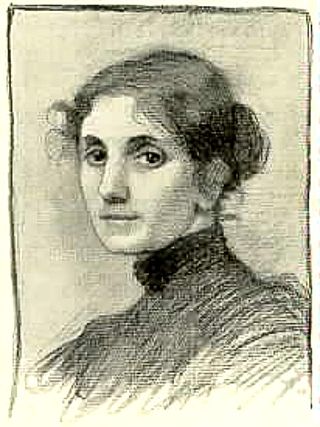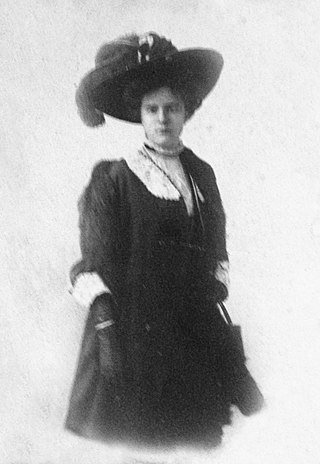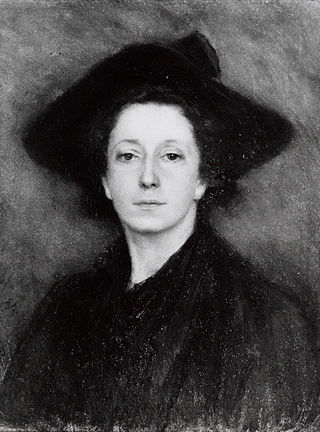Laure Coutan-Montorgueil | |
|---|---|
 | |
| Born | 1855 Dun-sur-Auron, France |
| Died | 1915 (aged 59–60) |
| Nationality | French |
| Known for | Sculpture |
Laure Coutan-Montorgueil (1855-1915), also known as Laure Coutan, was a French sculptor. [1]
Laure Coutan-Montorgueil | |
|---|---|
 | |
| Born | 1855 Dun-sur-Auron, France |
| Died | 1915 (aged 59–60) |
| Nationality | French |
| Known for | Sculpture |
Laure Coutan-Montorgueil (1855-1915), also known as Laure Coutan, was a French sculptor. [1]
Laure Coutan-Montorgueil née Martin was born in 1855 in Dun-sur-Auron. She studied with Alfred Boucher. [2] Coutan-Montorgueil exhibited her work in the Woman's Building at the 1893 World's Columbian Exposition in Chicago, Illinois. She died in 1915 in the 9th arrondissement of Paris. [3]

The World's Columbian Exposition, also known as the Chicago World's Fair, was a world's fair held in Chicago from May 5 to October 31, 1893, to celebrate the 400th anniversary of Christopher Columbus's arrival in the New World in 1492. The centerpiece of the Fair, held in Jackson Park, was a large water pool representing the voyage that Columbus took to the New World. Chicago won the right to host the fair over several competing cities, including New York City; Washington, D.C.; and St. Louis. The exposition was an influential social and cultural event and had a profound effect on American architecture, the arts, American industrial optimism, and Chicago's image.

Marianne Stokes was an Austrian painter. She settled in England after her marriage to Adrian Scott Stokes (1854–1935), the landscape painter, whom she had met in Pont-Aven. Stokes was considered one of the leading women artists in Victorian England.

Alice Brown Chittenden was an American painter based in San Francisco, California who specialized in flowers, portraits, and landscapes. Her life's work was a collection of botanicals depicting California wildflowers, for which she is renowned and received gold and silver medals at expositions. She taught at the Mark Hopkins Institute of Art from 1897 to 1941.

Zoé-Laure de Chatillon, née Delaune (1826–1908) was a French painter.
Blanche Jenkins was a British portrait painter.

The Woman's Building was designed and built in June 1892, for the World's Columbian Exposition held in Chicago in 1893; under the auspices of the Board of Lady Managers. Out of the twelve main buildings for the Exhibition, the Woman's Building was the first to be completed. It had an exhibition space as well as an assembly room, a library, and a Hall of Honor. The History of the World's Fair states, "It will be a long time before such an aggregation of woman's work, as may now be seen in the Woman's Building, can be gathered from all parts of the world again." The purpose of the building was to highlight woman's achievements, and challenge the traditional ways of thinking at the time it was built. The Woman's Building was planned, designed, and decorated entirely by women under the direction of the board of lady managers.

Pauline Dohn Rudolph (1865-1934) was an American painter. She was also a founder of the Chicago Palette Club.

Berthe Burgkan (1855–1936) was a French painter. She was known for her genre and flower paintings.
Emilie Jenny Weyl, (1855—1934) was a French sculptor. She exhibited at the 1893 World's Columbian Exposition in Chicago, the 1889 Exposition Universelle and the 1900 Exposition Universelle, both in Paris.

Abrahamina Arnolda Louise Hubrecht, (1855–1913) was a Dutch painter, etcher, and illustrator.

Marie Katharine Helene Tannæs (1854–1939), was a Norwegian painter known for her landscape paintings.
Ann Sophia Towne Darrah (1819–1881) was an American painter who often depicted the White Mountains of New Hampshire.
Mariquita Gill was an American painter who lived in Giverny, France during the 1890s.

Johanna Knowles Woodwell Hailman was an American painter known for her floral paintings and scenes of industrial Pittsburgh.
Hannah Tempest Jenkins (1855–1927) was an American painter and educator. She taught at Pomona College and founded The Rembrandt Club of Pomona College and Claremont, an art appreciation society that still exists.

Jeanne Royannez, also known as Madame Clovis Hugues (1855-1932) was a French sculptor.
Clara Augusta Amalie Emma Lobedan (1840–1918) was a German painter, watercolorist, pastelist, ceramicist, and craftsman.
Ida Josephine Burgess was an American artist known for her paintings, murals, and stained glass.

Alice Viola Guysi (1863–1940) was an American painter who served as the Director of Art in the Detroit Public Schools for over three decades. Her younger sister Jeanette Guysi mirrored her career in painting and teaching.